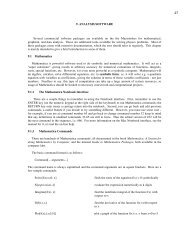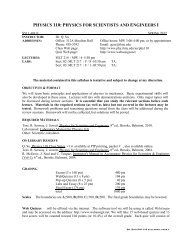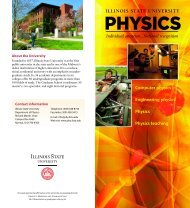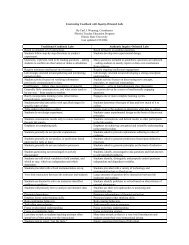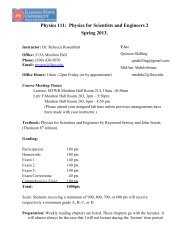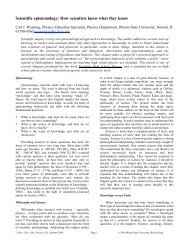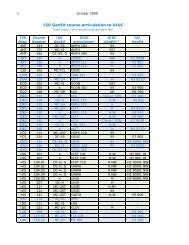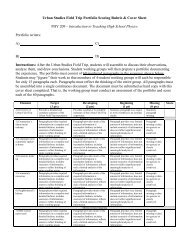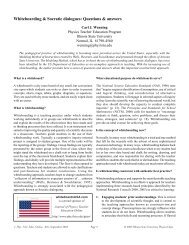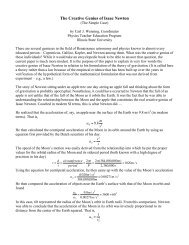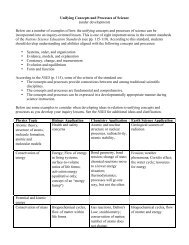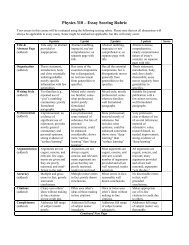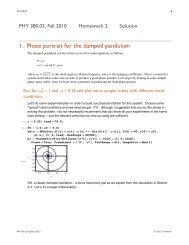PHY 102
PHY 102
PHY 102
You also want an ePaper? Increase the reach of your titles
YUMPU automatically turns print PDFs into web optimized ePapers that Google loves.
<strong>PHY</strong> <strong>102</strong><br />
Atoms to Galaxies<br />
Fall 2012<br />
Dr. Sadri Hassani<br />
314 Moulton Hall<br />
Tel: 438-3427; email: sdhassa@ilstu.edu<br />
Office hours: MWF 11:00–11:50 or by appointment<br />
Textbooks<br />
From Atoms to Galaxies (FAtG), Sadri Hassani, CRC Press, 2010 (required).<br />
Hands-on Activities for <strong>PHY</strong> <strong>102</strong> Atoms to Galaxies, by Jay Ansher and Shaukat Goderya (required).<br />
Overview<br />
The aim of this course is to introduce you to the methodology, history, and basic concepts of physics, as well<br />
as to some experimental techniques via traditional lab set-ups and computer simulations. On occasions, the<br />
connection between physical principles and the development of new technologies is also emphasized.<br />
Specific goals you will be expected to achieve<br />
As one of the four science literacy courses of the general education program at ISU, the main goal of this<br />
course is to acquaint you with the principles of science. As such, coming out of this course you will<br />
• understand how we know what we know about the physical universe,<br />
• be able to differentiate between science and pseudoscience,<br />
• understand the connection between physics, technology, and society,<br />
• have had hands-on experience with experiments which illustrate some of the theoretical ideas discussed<br />
in lectures,<br />
• recognize the crucial role of precise observation in formulating the nature of reality, strange and counterintuitive<br />
as this formulation may be,<br />
• have been exposed to some of the important physical ideas that led to quantum theory such as properties<br />
of motion, waves, electromagnetic radiation, and light,<br />
• have been exposed to the fundamentals of quantum theory as a paradigm of modern physics.<br />
Course Outline<br />
The course is divided into three parts. The first part deals with the beginning of science and astronomy.<br />
The second part is about classical physics, where many of the concepts and outlooks that led to quantum<br />
theory are discussed. The last part will concentrate on quantum theory, emphasizing the experimental<br />
evidence that led to the theory, its subsequent observational verification, and its theoretical consequences<br />
and predictions, as well as some of its applications.<br />
A glance at the schedule of the course shows that you are expected to read a great deal at a rapid pace.<br />
I will try to make this task easier for you in my lectures, but experience has shown that the best learning<br />
1
environment requires students’ inquisitive participation in the class. Ask questions; we shall all learn<br />
from them!<br />
Lab Activities<br />
A major component of the course is a collection of 10 lab activities each worth 5 points. The lowest lab grade<br />
will be dropped. The activities take place in an open lab. This means that you can walk in and perform<br />
the running activity any time during the hours in which the lab is open (see <strong>PHY</strong> <strong>102</strong> Lab Schedule for<br />
details). Since there are over 400 students using the lab, I strongly suggest that you perform the<br />
activities early in the week. Because of the constant accessibility of the lab room, there is no make-up<br />
for a missed activity! The deletion of the lowest score allows for a week-long emergency per student.<br />
With such a large student population of <strong>PHY</strong> <strong>102</strong>, it is possible for your graded lab reports left in the<br />
lab rooms to disappear, and with them, the evidence of what your lab grades were. On the Tuesday of the<br />
second week after the lab (if the lab is open; otherwise the Tuesday after that), your graded lab reports<br />
should be available.<br />
Box 1. You have to pick up your graded labs and keep them until the end of the semester.<br />
If you have a missing lab grade and you don’t have your graded lab report for that lab, the<br />
missing grade will count as zero!<br />
Tests<br />
To make sure that you are keeping up with the reading assignments, I will periodically give you quizzes of<br />
two types:<br />
• The Mallard quizzes can be taken several times and they are helpful in preparing you for the in-class<br />
quizzes. Each Mallard quiz consists of one question and earns you one point. There will be as many as<br />
20 Mallard quizzes. You can see your scores by clicking on “View Grade” icon in Mallard. The total is<br />
also recorded on ReggieNet. The maximum number of times you can submit a quiz and get full credit<br />
is 5. After that you lose 10% of the grade for each extra submission.<br />
Box 2. Take each Mallard quiz as many times as you wish. It will not affect your<br />
score because only the highest score will be recorded as your grade.<br />
• There are 6 regular quizzes, all announced in the syllabus. Each quiz consists of 10 multiple-choice<br />
questions and is worth 10 points. The lowest of the 6 quiz scores will be dropped. Be prepared at all<br />
times! Bring a soft number 2 pencil for the written quizzes and tests! Most tests require a<br />
scientific calculator.<br />
In addition to the quizzes, there will be four hour exams, three of which consist of 25 multiple-choice<br />
questions, each question worth 1 point. The last exam is just the final, and it will consist of 35 questions on<br />
topics covered after the third exam.<br />
Box 3. Bring your own calculator (live batteries included) to tests and quizzes!<br />
phones or sharing of calculators are allowed.<br />
No cell<br />
2
Seat Assignment and Attendance<br />
On the second day of classes, you will be assigned a seat, and you are expected to sit there for the rest of<br />
the semester. You are not required to attend the lectures. However, if you decide to come to the lecture,<br />
you are expected to remain seated until the end of the period. If for any reason you need to leave<br />
in the middle of the lecture, write your name and the time you have to leave on a piece of paper and give it<br />
to me before the class starts. You may leave when I call your name.<br />
Prerequisites<br />
No science background is required for <strong>PHY</strong> <strong>102</strong>. This does not mean, however, that the course is void of<br />
new and unfamiliar concepts. On the contrary, even if you have already had physics in high school, the<br />
topics covered here may appear unfamiliar, because the course emphasizes neither memorization nor mere<br />
“hands-on” recreation, but rather, true learning experience. When a certain topic is introduced, examples of<br />
its application will be analyzed in detail. You are then expected to be able to analyze other new examples.<br />
This requires an in-depth comprehension of the topics. Although the process of learning will be slow at the<br />
beginning, a little bit of patience and diligence can go a long way. The most important prerequisite for the<br />
course is a willingness to learn. As for the mathematics preparation, some very basic algebra skills such as<br />
taking square roots, raising to powers, and using power-of-ten notation, will be assumed. As you will see,<br />
it is not a good mathematical skill that ensures success in the course but the ability to apply the skill to<br />
physical situations.<br />
Grades<br />
Your total grade is divided into four parts as shown in the following table:<br />
In-Class Quizzes<br />
Mallard Quizzes<br />
Labs<br />
Hour Exams<br />
Final<br />
Total<br />
50 points<br />
20 points<br />
45 points<br />
3 × 25 = 75 points<br />
40 points<br />
230 points<br />
The dates of the exams and the announced quizzes as well as the due dates for activities are as given in<br />
the following schedule. Changes, if any, will be announced in advance. The final is simply the fourth exam.<br />
There will be no make-up quizzes or exams! However, if for some legitimate and documented reason<br />
you don’t show up for a test, the score for that test will be the average of all similar tests you took during<br />
the entire semester. Your letter grade will be based on a distribution curve. The percentage range of letter<br />
grades is approximately as follows:<br />
A: 82–100, B: 72–81, C: 57–71, D: 45–56<br />
Box 4. If you are taking this course on a pass/fail basis, you need a C to pass the course.<br />
Tips on Studying for Exams and Quizzes<br />
• Go over the examples and exercises discussed in the class and in the book.<br />
• Here is the best tip: Be able to reproduce examples without looking at your notes. If you cannot<br />
do this, you have not learned the material!<br />
• When studying for an hour exam, in addition to the previous tip, make sure you can answer—on your<br />
own—all the questions in all relevant quizzes taken after the last hour exam.<br />
3
• Study in groups: Your best teachers are your classmates!<br />
Box 5. All of the text segments designated as Food for Thought in the assigned chapters are required<br />
readings.<br />
Schedule<br />
The following is a tentative schedule. Changes will be announced in advance. The reading assignments<br />
come from the textbook From Atoms to Galaxies (e.g., FAtG: Sec. 1.1, 1.2).<br />
All lab activities begin on Tuesday and are due on Friday.<br />
Box 6. You are responsible for remembering the dates of quizzes and hour exams!<br />
Date<br />
Assignment<br />
Aug. 20 Introduction and Ancient Astronomy (FATG: Sec. 1.1, 1.2)<br />
22 Ancient Astronomy (FATG: Sec. 1.3)<br />
24 Ancient Astronomy (FATG: Sec. 1.3)<br />
Sept. 03<br />
Qct. 01<br />
27 Ancient Astronomy (FATG: Sec. 1.4)<br />
29 Modern Astronomy (FATG: Sec. 3.1)<br />
31 Modern Astronomy (FATG: Sec. 3.2)<br />
Labor Day; A2-GA: Graphical Analysis<br />
05 Modern Astronomy (FATG: Sec. 3.3); Quiz #1<br />
07 Modern Astronomy (FATG: Sec. 3.3)<br />
10 Rectilinear Motion (FATG: Sec. 4.3); A5-CI: Computer Interface<br />
12 Hour Exam #1 (Astronomy: Chs. 1, 3)<br />
14 Rectilinear Motion (FATG: Sec. 4.3)<br />
17 Rectilinear Motion (FATG: Sec. 4.3); No lab this week!<br />
19 Kinematics (FATG: Sec. 6.1)<br />
21 Kinematics (FATG: Sec. 6.3)<br />
24 Kinematics (FATG: Sec. 6.4); Quiz #2 ; A3-FF: Free Fall<br />
26 Dynamics (FATG: Sec. 4.1, 4.2)<br />
28 Dynamics (FATG: Sec. 7.1)<br />
Dynamics (FATG: Sec. 7.2); A4-PM: Projectile Motion<br />
03 Dynamics (FATG: Sec. 7.3); Quiz #3<br />
05 Dynamics (FATG: Sec. 7.3)<br />
08 Further Topics (FATG: Sec. 8.1); A6-NSL: Newton’s Second Law<br />
4
10 Hour Exam #2 (Motion: Chs. 4, 6, 7)<br />
12 Further Topics (FATG: Sec. 8.1) Last day to withdraw from the course with a WX grade<br />
15 Waves (FATG: Sec. 11.1, 11.2); A7-CE: Conservation of Energy<br />
17 Waves (FATG: Sec. 11.2)<br />
19 Waves (FATG: Sec. 11.3)<br />
22 Electromagnetism (FATG: Sec. 12.1, 12.2); No lab this week!<br />
24 Electromagnetism (FATG: Ch. 13); Quiz #4<br />
26 Electromagnetism (FATG: Ch. 13)<br />
29 Electromagnetism (FATG: Ch. 14); B3-CLE: Coulomb’s Law of Electrostatics<br />
31 Birth of Quantum Theory (FATG: Ch. 20); Quiz #5<br />
Nov. 02 Birth of Quantum Theory (FATG: Ch. 20)<br />
05 Birth of Quantum Theory (FATG: Ch. 20); B1-WA: Wave Addition<br />
07 Hour Exam #3 (Energy, Waves, EM: Chs. 8, 11–14)<br />
09 The Atoms (FATG: Ch. 21)<br />
12 The Atoms (FATG: Ch. 21); B2-WNL: Wave Nature of Light<br />
14 Probability (FATG: Ch. 16)<br />
16 Probability (FATG: Ch. 16)<br />
19 Thanksgiving Vacation<br />
21 Thanksgiving Vacation<br />
23 Thanksgiving Vacation<br />
26 The Quantum Theory (FATG: Ch. 22); D1-LFA: Light From Atoms<br />
28 The Quantum Theory (FATG: Ch. 22); Quiz #6<br />
30 The Quantum Theory (FATG: Ch. 22)<br />
Dec. 03 The Quantum Theory (FATG: Ch. 22); No lab this week!<br />
05 Consequences of Quantum Theory (FATG: Ch. 23.1)<br />
07 Consequences of Quantum Theory (FATG: Ch. 23.6)<br />
Final = Test #4<br />
Content: Quantum Physics and Probability: Chs. 16, 20–23<br />
Time & Place: Sec 9/10 (MWF 12:00–12:50): TBA<br />
Sec 13/14 (MW 9:05–9:50): TBA<br />
5



